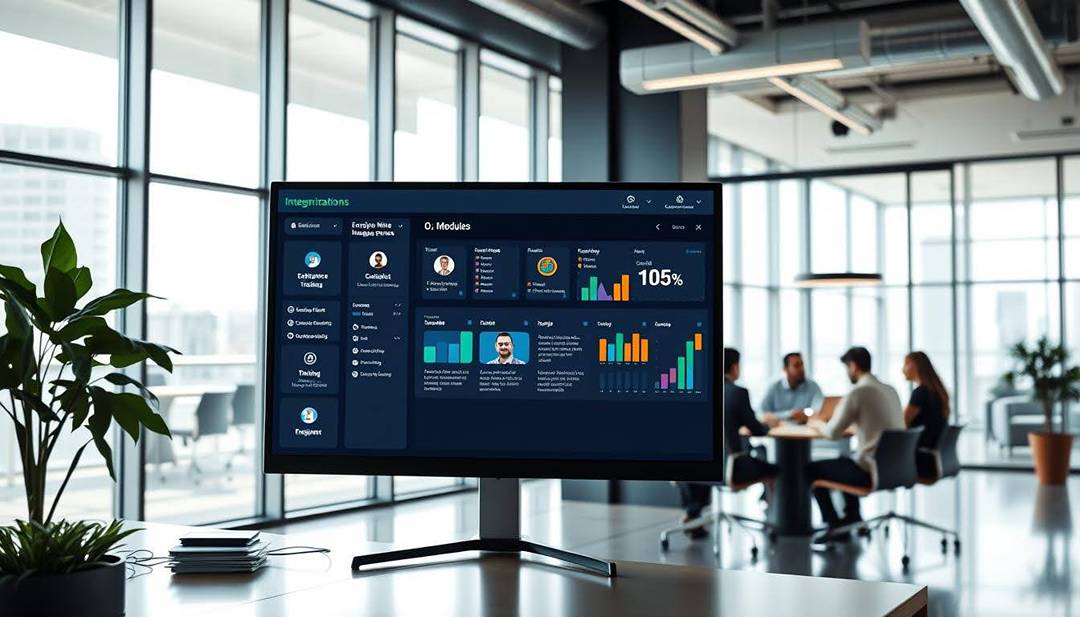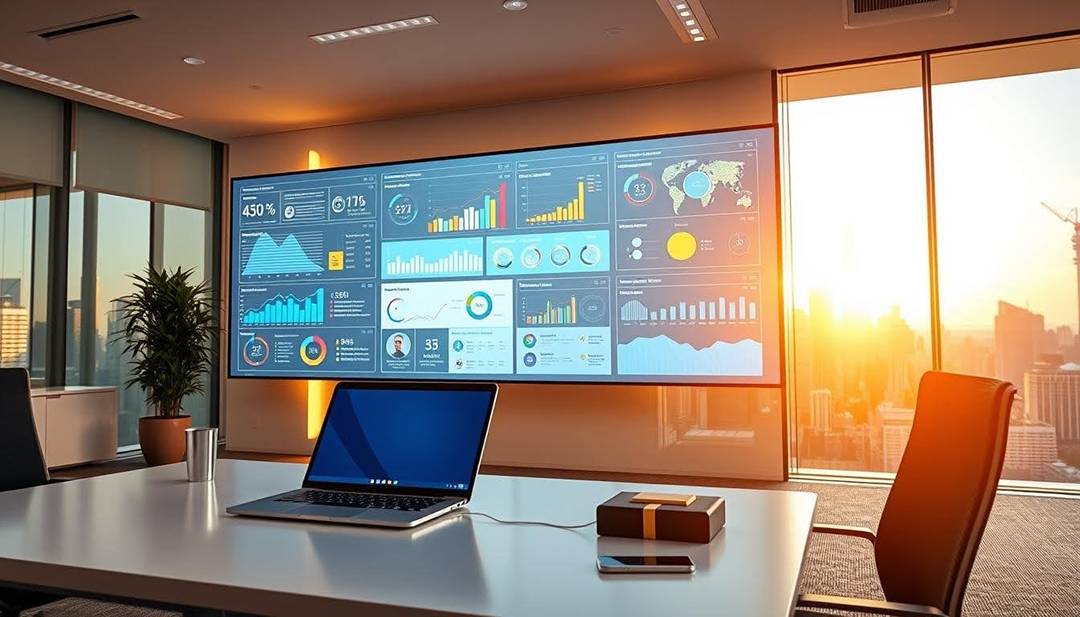
How Employee Management Software Enhances Training and Communication in LMS and Intranets
Modern companies are making their workplaces more efficient with new technology. Employee management software is key in making training and talking easier. It connects learning systems with intranets, making workspaces better for everyone.
Big names like Google and Microsoft are leading the way in digital workspaces. Their software helps put all training in one place, tracks growth, and makes talking easier. This helps HR teams make learning more fun and interactive.
Putting learning systems and employee software together is a big step forward. Now, companies can use data to make training better, see how employees are doing, and help them grow. This makes learning more personal and cuts down on busy work.
Good employee software solves many problems, like making communication better, making new hires easier, and making the company more open. Using these smart tools, businesses can get more done and keep employees happy.
Understanding the Integration of Employee Management Software in Modern Workplaces

Modern workplaces are changing fast with advanced employee management software. These tools are key for making HR work smoother and improving how things get done. Companies use full intranet solutions to connect teams, track how well they're doing, and make managing the workforce easier.
Employee management software brings together many workplace tasks. It handles everything from finding new employees to checking how well they're doing. It creates a single place for managers to see how the team is doing, give tasks, and look at important numbers. It works well with intranets to share information and talk easily between different teams.
Big tech companies like Google and Microsoft have made top-notch employee management software. It lets teams work together in real time. It has tools for tracking skills, keeping an eye on professional growth, and making reports automatically. This way, companies can make better choices about who to hire and how to use their resources.
Using employee management software smartly helps businesses cut down on paperwork, talk better as a team, and be more open about work. As technology keeps changing, these tools will be even more important for companies wanting to get the most out of their people.
The Evolution of Learning Management Systems and Corporate Intranets

The way we learn and communicate at work has changed a lot in the last 20 years. Learning management system (LMS) isnow key for companies to improve training. What started as simple storage for training materials has grown into advanced platforms for personalized learning.
Corporate intranets have also changed a lot. They used to be just simple websites. Now, they are dynamic hubs for communication and learning, working well with LMS systems. They give employees access to many resources, tools for working together, and interactive learning.
With more people working from home, digital platforms have become even more important. Companies need LMS systems that can handle training for remote workers. Features like mobile access, AI for suggesting content, and tracking progress in real-time are now expected.
By linking employee management software with learning platforms, companies have created better work environments. They can track how employees are growing, match training with company goals, and offer learning that helps both individuals and the company succeed.
Streamlining Training Programs Through Automated Management Tools
Modern companies are changing how they train employees with advanced software. These tools make learning personal, fitting each worker's needs and skill gaps.
Today's learning systems track how well employees are doing in training. They use data to spot where skills need improvement. This helps companies create training that really meets their goals.
By combining employee software with learning platforms, companies get deep insights into their teams. They can see who needs what training, suggest specific courses, and track progress closely.
Automated tools make training easier by cutting out the need for manual steps. Managers can assign courses, see who's done them, and check if training is working. This saves time and boosts learning results.
Using these advanced tools, businesses can stay ahead. They can quickly improve their teams, meet new skill demands, and keep learning a big part of their culture.
Enhanced Communication Channels in Digital Workspaces
Digital workspaces have changed how companies talk and work together. Employee management software makes old ways of talking obsolete. It turns companies into one big information hub.
These platforms let teams talk easily, no matter where they are. They break down walls between different parts of the company and different places.
Today's employee management software has cool tools for talking. It's not just emails anymore. There are chat rooms, forums, and dashboards for projects. These help teams share ideas and work together better.
Being able to work from anywhere is key. Employees can use phones or tablets to get to the company's intranet. This means everyone can stay in touch, no matter where they are or when they work.
Using the right employee management software makes talking easier for everyone. It puts all the info in one place and has tools that are easy to use. This makes talking inside the company better, keeps employees happy, and makes work flow smoother.
Employee Management Software: Features and Capabilities
Employee management software has changed how companies manage their teams. These tools make HR tasks easier by combining many features. They help improve work efficiency from finding new employees to tracking performance.
These systems have advanced talent management tools. They track employee data, do performance reviews, and plan the workforce. Companies can now make better decisions with real-time team insights.
Analytics and reporting are key features. They give detailed dashboards to see team performance and skills. This helps leaders understand where to improve and grow.
Recruitment is also improved. The software makes finding the right candidates easier. It tracks applicants and helps HR find the best talent fast. It also connects with learning systems for better onboarding and training.
HR teams use these tools to make managing the workforce better. By choosing the right software, companies get valuable insights. This leads to more engaging and productive workplaces.
Measuring Training Effectiveness and ROI
Today, companies use powerful learning management systems to check if their training works. Employee management software has changed how they see the value of training. It shows how much they get back from their investment in their team's skills.
Key performance indicators (KPIs) are important for knowing if training is effective. Modern systems track things like how many finish courses, what skills they learn, and how well they remember what they learned. This information helps see how training affects the workplace.
Numbers tell a story about how training helps employees do better. Employee management software makes it easy to see how training leads to better work, fewer mistakes, and stronger skills at work.
With advanced analytics, HR can make detailed reports. These reports show what's working in training, what needs work, and why investing in employees is worth it.
Using data to make decisions helps companies improve their training. This way, they can keep making their team stronger and more capable.
Best Practices for Implementation and User Adoption
Getting employee management software to work well needs more than just setting it up. It's important to manage changes well. This ensures everyone in the company can use it smoothly.
Start by making a detailed training plan. It should meet the needs and worries of your employees. Good training makes the system easy for everyone, no matter their tech skills.
Using a step-by-step approach helps a lot. Begin with a small group to test and give feedback. These early users can show others how easy it is to use.
Good communication is essential. Leaders should explain why you're using this new system. They should talk about how it will make work easier and better for everyone.
Keep supporting your team after you've set it up. Make sure there are ways for them to get help, guides, and more training. This will help them feel sure and confident.
By focusing on making it easy for users, training well, and planning carefully, you can make your software work great. This will help your workplace become more connected and efficient.
Security and Compliance in Integrated Systems
Data protection is key in today's workplace. Employee management software now has top-notch security to keep company info safe. It uses strong login checks to make sure only the right people can get into important systems.
Keeping up with rules is very important for companies using digital tools. The latest employee management software meets global standards like GDPR and CCPA. It has detailed access controls, encryption, and logs to keep employee data safe from hackers.
Cybersecurity experts say using more than one way to log in is a must. Now, learning management systems have advanced ways to check who you are. They use things like face scans, checking devices, and watching for threats in real time.
Keeping data private is crucial while still talking and working together online. The best systems use full encryption to keep employee info safe everywhere online. Companies can now find a balance between new tech and strong security.
Choosing the right employee management software means looking at its security features. IT folks should find solutions that keep getting better, report on compliance, and can adapt to new threats.
Future Trends in Workplace Management Technology
The world of workplace technology is changing fast. Artificial intelligence is making employee management software smarter. It can now predict what the workforce needs and improve how well organizations work.
Virtual and augmented reality are changing learning systems. They offer training that feels real. This lets employees learn new skills in a way that's not limited by classrooms.
Predictive analytics are key in planning the workforce. Today's employee management software uses advanced data tools. These tools help companies see what talent they need, find skill gaps, and plan for hiring. This keeps businesses ahead in the changing job market.
Intranet platforms are also changing a lot. Cloud-based and AI-powered, they make talking to each other inside the company easier. Employees can find information, work together, and share things quickly and easily.
The future of workplace tech is about making systems that work together and adapt to what the company needs. Companies that use the latest employee management software will have an edge in finding, training, and keeping talent.
Conclusion
Employee management software is a big step forward in workplace tech. It combines learning systems and intranets to boost training and communication. This makes work environments more dynamic and engaging.
For this software to work well, it needs a focus on user experience and tech compatibility. Companies like Google and Microsoft show how it can improve training and productivity. It offers personalized learning, tracks performance, and keeps teams connected.
Business leaders should look at their current systems to see where they can improve. Employee management software can make training better, communication smoother, and growth faster. Investing in this tech helps teams stay ahead in today's fast-changing work world.
The future of work is about smart, connected tech that supports learning and communication. Companies that use this software will attract and keep the best talent. They'll be ahead in many industries.

Comments (0)